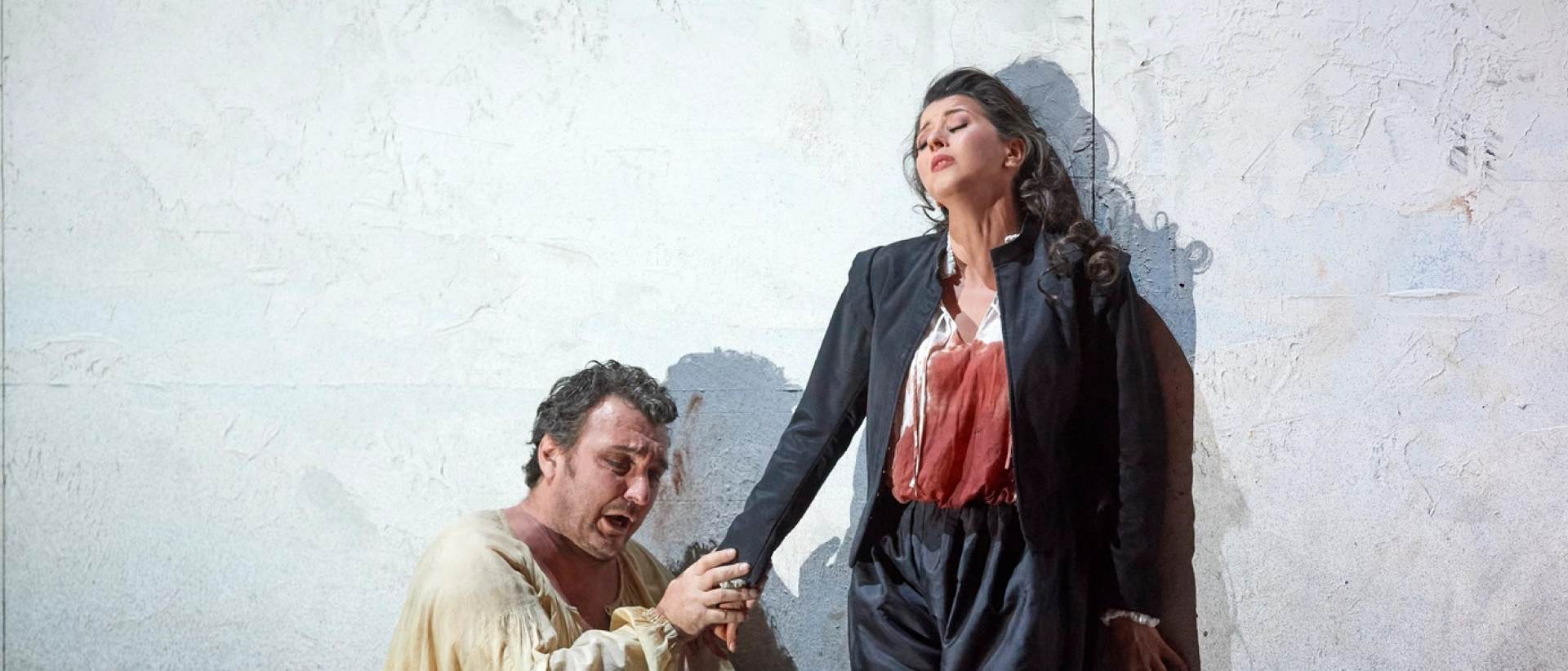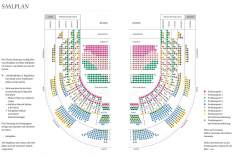Rigoletto
Mo | Tu | We | Th | Fr | Sa | Su |
ACT 1
At a party, the Duke of Mantua explains that he has been pursuing a young woman he doesn't know for weeks.
He finds fidelity ridiculous; all women are attractive to him. He has just set his sights on Countess Ceprano, egged on by his court jester Rigoletto. Marullo tells the other courtiers about his latest discovery: the ugly Rigoletto seems to have a mistress. As Rigoletto is hated at court but unassailable, the courtiers - led by Count Ceprano - want to take revenge on him and plan to kidnap his supposed lover.
When Rigoletto mocks Count Monterone, who accuses the Duke of dishonoring his daughter, Monterone curses the despot and his cynical functionary.
On his way home, Rigoletto encounters the contract killer Sparafucile. When he unexpectedly offers him his services, Rigoletto is interested. He recognizes his own reflection in Sparafucile; they are both outsiders.
Troubled by Monterone's curse, Rigoletto blames society and his dubious profession for his own wickedness.
With his daughter Gilda, whom he keeps hidden away from the world, Rigoletto wants to find all the happiness that life denies him. He avoids all her questions about her and his identity. For fear of losing her, Rigoletto forbids his daughter to have any contact with the outside world apart from going to church. Nevertheless, a young man secretly courts her. It is the Duke, who pretends to be a penniless student.
As Rigoletto leaves the house, the Duke storms Gilda with declarations of love that seem to make her maiden dreams come true. Noise in the street forces the Duke to leave: the courtiers come to abduct Rigoletto's "sweetheart". Rigoletto, blinded by a mask, even helps them - in the belief that the Countess Ceprano is being stolen. Rigoletto realizes the truth too late.
ACT 2
The Duke finds Rigoletto's house deserted. He laments the loss of his beloved, for whom he believes he feels deep affection for the first time.
At court, he learns that Gilda has been abducted to the palace by his courtiers and hurries to her. Rigoletto desperately searches for his daughter, but the courtiers leave him in the lurch, even when he tells them that they have not abducted his mistress, but his daughter. When the Duke sends Gilda away, she tries to confide in her father. But Rigoletto thinks only of bloody revenge.
ACT 3
In order to finally "cure" Gilda of her love for the Duke, Rigoletto takes her to Sparafucile's house
and forces her to watch as the Duke pleasures himself with the prostitute Maddalena (Sparafucile's sister). Rigoletto sends his daughter away to prepare their escape and instructs Sparafucile to kill the Duke. But Gilda returns secretly and witnesses how Maddalena persuades her brother to murder the first person who comes along before midnight instead of the Duke.
Gilda then decides to sacrifice herself for her love. She knocks on the door. A little later, Sparafucile hands Rigoletto the body in a sack. At the moment of his greatest triumph - Rigoletto feels like an all-powerful avenger - he hears the Duke's voice. Horrified, he opens the sack and sees his dying daughter. Without understanding the course of events, Rigoletto blames Monterone's curse for the tragedy.
ACT 1 - 60 MIN
INTERMISSION - 25 MIN
ACT 2 & 3 - 75 MIN
Program and cast
Herzog von Mantua: Dmitry Korchak
Rigoletto: Amartuvshin Enkhbat
Gilda: Nina Minasyan
Sparafucile: Ivo Stanchev
Maddalena: Monika Bohinec
Musical Direction: Carlo Rizzi
Production: Pierre Audi
Stage and costumes: Christof Hetzer
Light: Bernd Purkrabek
Dramaturgy: Bettina Auer
Vienna State Opera
Public Transport
Subway lines: U1, U2, U4
Trams: 1, 2, D, J, 62, 65
Buses: 59A
Local Railway: Badner Bahn
Stops: Karlsplatz / Opera
Taxi stands are available nearby.
Parking
Parking is only € 6, - for eight hours!
The Wiener Staatsoper and the ÖPARK Kärntner Ring Garage on Mahlerstraße 8, under the “Ringstraßengalerien”, offer the patrons of the Vienna State Opera a new, reduced parking fee. You can park in the Kärntner Ring Garage for up to 8 hours and pay only a flat fee of € 6, -. Just validate your ticket at one of the discount machines inside the Wiener Staatsoper. The normal rate will be charged for parking time greater than 8 hours. The validation machines can be found at the following coat checks: Operngasse, Herbert von Karajan-Platz, and the right and left and balcony galleries.
Important: In order to get the discount, please draw a ticket and do not use your credit card when entering the garage!
After devaluing your ticket in the Wiener Staatsoper you can pay comfortably by credit card or cash at the vending machines.
The machines accept coins and bills up to 50.- Euro. Parking time longer than 8 hours will be charged at the normal rate.
History
The structure of the opera house was planned by the Viennese architect August Sicard von Sicardsburg, while the inside was designed by interior decorator Eduard van der Nüll. It was also impacted by other major artists such as Moritz von Schwind, who painted the frescoes in the foyer, and the famous "Zauberflöten" (“Magic Flute”) series of frescoes on the veranda. Neither of the architects survived to see the opening of ‘their’ opera house: the sensitive van der Nüll committed suicide, and his friend Sicardsburg died of a stroke soon afterwards.
On May 25, 1869, the opera house solemnly opened with Mozart's Don Giovanni in the presence of Emperor Franz Joseph and Empress Elisabeth.
The popularity of the building grew under the artistic influence of the first directors: Franz von Dingelstedt, Johann Herbeck, Franz Jauner, and Wilhelm Jahn. The Vienna opera experienced its first high point under the direction of Gustav Mahler. He completely transformed the outdated performance system, increased the precision and timing of the performances, and also utilized the experience of other noteworthy artists, such as Alfred Roller, for the formation of new stage aesthetics.
The years 1938 to 1945 were a dark chapter in the history of the opera house. Under the Nazis, many members of the house were driven out, pursued, and killed, and many works were not allowed to be played.
On March 12, 1945, the opera house was devastated during a bombing, but on May 1, 1945, the “State Opera in the Volksoper” opened with a performance of Mozart's THE MARRIAGE OF FIGARO. On October 6, 1945, the hastily restored “Theaters an der Wien” reopened with Beethoven's FIDELIO. For the next ten years the Vienna State Opera operated in two venues while the true headquarters was being rebuilt at a great expense.
The Secretary of State for Public Works, Julius Raab, announced on May 24, 1945, that reconstruction of the Vienna State Opera would begin immediately. Only the main facade, the grand staircase, and the Schwind Foyer had been spared from the bombs. On November 5, 1955, the Vienna State Opera reopened with a new auditorium and modernized technology. Under the direction of Karl Böhm, Beethoven’s FIDELIO was brilliantly performed, and the opening ceremonies were broadcast by Austrian television. The whole world understood that life was beginning again for this country that had just regained its independence.
Today, the Vienna State Opera is considered one of the most important opera houses in the world; in particular, it is the house with the largest repertoire. It has been under the direction of Dominique Meyer since September 1, 2010.

 EN
EN DE
DE IT
IT FR
FR ES
ES RU
RU JP
JP RO
RO
 Seating plan
Seating plan